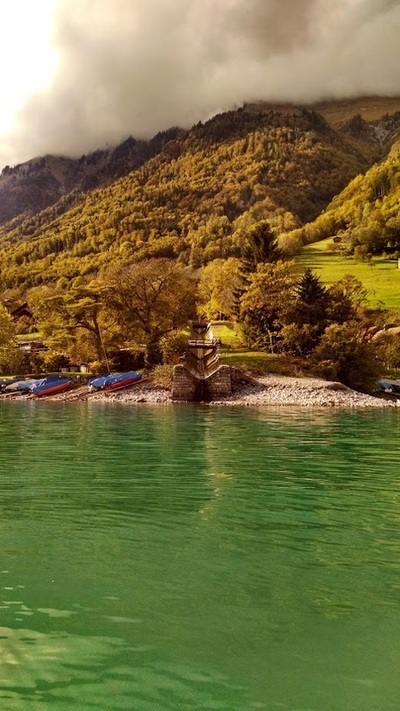| Every year, the Windhappers Kayak/Canoe Club celebrates the end of summer paddling season and the beginning of winter paddling with a short paddle and campfire in a nearby park. The Windhappers Kanovereniging (windchasers kayak/canoe club) is a paddling club based in Den Haag (the Hague) in the Netherlands. Every Wednesday evening, members gather at the swanky clubhouse to either (1) practice kayak polo, (2) go for an evening paddle, or (3) loiter around the bar. Elizabeth and I visited a few weeks ago and participated in item #3. I asked at least 5 people how the club works, and how an experienced member can join and use the equipment. They seemed baffled by the fact that:
Click below to read more about our first club impressions! |
|
1 Comment
Lake Brienz (Brienzersee in German) is one of two lakes that flank the city of Interlaken, Switzerland. Unlike the Lake Thun (the other lake), Lake Brienz is a vibrant turquoise blue color, likely caused by glacial sediments flowing into the lake. I rented a boat from Hightide Kayak School in Bönigen (next to Interlaken) and embarked on my longest solo paddle yet. As you can see from the photos below, the views and weather were fantastic!
Note: I'm trying out a new layout with this post, with all photos + captions up front and the detailed trip description later on. Let me know what you think!
This was the first field visit for the EMERGO project, a project by TU Delft and NIOZ (the Netherlands Institute of Sea Research) that I'll be working on during my time in the Netherlands. The overarching goal is to understand the morphological and ecological responses of tidal flats to different restoration measures. The project was sparked, in part, by the ongoing loss of intertidal habitats (tidal flats, oyster reefs, marshes, sea grasses) in the Oosterschelde. Between 1976 and 1986, a storm surge barrier was constructed across the mouth of the river. This barrier was the largest component of the 50 year Delta Works flood management project to protect the Netherlands from flooding after devastating floods in 1953. Stay tuned for a future post about this barrier - an epic bike trip is in the works that will involve biking across many of the storm surge barriers.
Anyways, the barrier reduced the tide range in the river (i.e. the tide does not go as high or as low as it used to). Since intertidal habitats depend on being dry and wet for a certain amount of time, this smaller tide range has lead to rapid shrinking and loss of tidal flat and marsh habitat. Many pilot projects are in the ground already to test ways to slow/stop this degradation, including artificial oyster reefs and tidal flat sand replenishments. The EMERGO project will look at how well these (and other) actions address the unraveling of intertidal habitats. Let's visit some artificial and natural oyster reefs!
How can oyster reefs help restore the Oosterschelde?
|
Welcome!This is a blog about exploring the outdoors (mostly by kayak), traveling, trip planning, and coastal engineering. It currently focuses on kayaking in the Netherlands and Belgium, but previous posts cover Upstate New York, California, and much more. See the Complete List of Blog Posts for a history of the site. Looking for something specific? Search the site here.
In addition to the blog, check out the Water Nerd section, where I write about coastal engineering and hydrology. Happy Paddling! Nena Subscribe Here!Email updates on new blog posts, about once per month.
Reader TipsClick the "Read More" link at the bottom of each summary for more photos, to see an interactive map of the route, and to read about the adventure.
Maps in each blog post: Click the icons to learn more about the launch site (amenities) and destinations. Click the square in the bottom-left corner to see an aerial photo behind the route. Archives
December 2020
Categories
All
Click the RSS Feed link, copy the URL, and paste it into your favorite feed reader.
|





















 RSS Feed
RSS Feed

